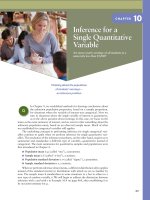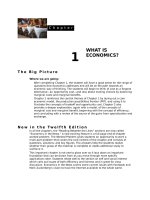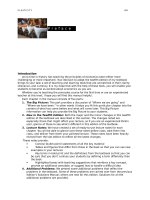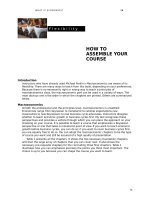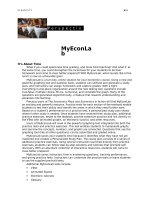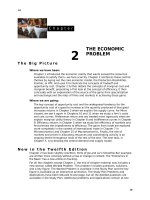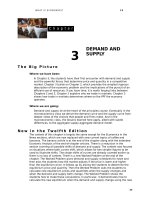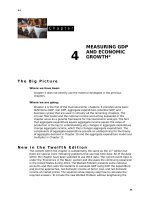The big picture marcoeconomics 12e parkin chapter 06
Bạn đang xem bản rút gọn của tài liệu. Xem và tải ngay bản đầy đủ của tài liệu tại đây (357.98 KB, 12 trang )
W H AT I S E C O N O M I C S ?
49
6
ECONOMIC
GROWTH**
The Big Picture
Where we have been:
Chapter 6 focuses on economic growth. It uses the definitions and concepts of
aggregate income and real GDP presented in Chapter 4 as well as tying
economic growth in the macroeconomy to the PPF of Chapter 2.
Where we are going:
Chapter 6 is the first of four chapters that examine the economy in the long
run when the economy is at full employment. The following chapters focus on
finance and investment, money and the price level, and the exchange rate and
balance of payments. After these chapters the next section examines
macroeconomic fluctuations by developing the AS-AD model. The material
presented in Chapter 6 provides the long run fundamental variables and
results that need to be remembered as various other models are developed in
future chapters. Chapter 6 (and Chapter 7) is particularly useful in Chapter 13
when the supply-side effects of fiscal policy are covered.
N e w i n t h e Tw e l f t h E d i t i o n
The chapter’s content and coverage are about the same as the 11 th edition. All the
data are updated through 2014. The Worked Problem gives data about China’s
real GDP and population in two years and then asks the students to calculate the
growth rate of China’s real GDP growth rate and its standard at living. The
question also asks the students to use the Rule of 70 to approximate how long it
will take for China’s standard of living to double. The solutions work step-by-step
through the calculations necessary to answer the questions. To include the new
Worked Problem without lengthening the chapter, some problems have been
removed from the Study Plan Problem and Applications. These problems are in the
MyEconLab and are called Extra Problems.
49
Lecture Notes
Economic Growth
You can start your discussion of this chapter by listing on the board or on an overhead
various countries ranked from highest per capita real GDP to lowest. It is a real eye opener
for students to consider income per person because it really shows how fortunate we are in
the United States. Tell your students that in the 1960s countries like Hong Kong, Singapore
and Japan used to rank around where China ranks today. Explain that this extraordinary
growth is part of what motivated economists over the last 20-30 years to try to deduce how
this type of growth can occur. Is it possible the United States could do something differently
to grow at those growth rates? Is the neoclassical model correct in its prediction that there
will be a global equilibrium in which all nations have the same real GDP per person? Then
leave your students with the fact that China is 200 times the population of Hong Kong and
4 times the population of the United States. This brings the obvious question: Should we be
concerned?
Economic growth leads to large changes in standards of living from one generation
to the next.
Economic growth rates vary across countries and across time.
There are different economic theories to explain these variations in growth rates.
I. The Basics of Economic Growth
The economic growth rate is the annual percentage change of real GDP. This
growth rate is equal to:
Real GDP growth rate =
Real GDP in current year Re al GDP in past year
100
Re al GDP in past year
The standard of living depends on real GDP per person, which is real GDP divided
by the population. The growth rate of real GDP per person can be calculated using
the formula above, though substituting real GDP per person.
The growth rate of real GDP per person also approximately equals the growth rate of
real GDP minus the population growth rate.
Real GDP can increase for two distinct reasons: The economy might be returning to full
employment in an expansion phase of the business cycle or potential GDP might be
increasing.
The movement from point A to point B
reflects an expansion phase of the
business cycle. It occurs with no change in
production possibilities. Such an expansion
is not economic growth.
The increase in aggregate production
reflected by the movement from point B on
PPF0 to point C on PPF1 is economic growth
—it reflects an expansion of production
possibilities shown by an outward shift of
the PPF.
The Rule of 70 is useful for determining how long it will take for a variable to double. The
Rule of 70 states that the number of years it takes for the level of any variable to double
is approximately 70 divided by the annual percentage growth rate of the variable.
ECONOMIC GROWTH
Run through an example of the rule of 70 that does not relate to economic growth.
Examples: If tuition rates rise at 6 percent per year, how long will it take it to double? 70/6
= 11.67 years. If you invest $10,000 at 12 percent interest, how long will it take to double
your money? 70/12 = 5.83 years.
Compound Interest: You can reinforce the importance of economic growth by relating
the fact that if real GDP per person had grown just 0.25 percentage points faster between
1960 and the present, every household today, on average, would have almost $12,000
more income (every person would have $4,500 more). If real GDP per person had grown 1
percentage point faster between 1960 and the present, every household today, on
average, would have $50,000 more income (every person would have $21,200 more).To
make concrete just how much better off we would have been, get the students to list what
they would buy with an extra $21,200 a year.
II. Long-Term Growth Trends
Long-Term Growth in the U.S. Economy
The growth of real GDP per person in the United States has fluctuated but has averaged 2
percent per year over the last century. The growth rate was 1.8 percent prior to the Great
Depression and 2.1 percent after World War II.
Real GDP Growth in the World Economy
Economic growth varies across countries. Among richest countries, there seems to be some
convergence of real GDP per person but most other countries show less evidence of
convergence. The “Asian Miracle” is the fast rate of convergence for Hong Kong, Singapore,
Taiwan, Korea, and China.
Is there convergence or divergence in standards of living? What is the role of economic
growth for economic inequality? These are highly controversial questions. Most antiglobalization activists treat it as incontrovertible that economic growth creates higher
inequality. But this view is likely incorrect. First, there has been a general convergence of
standards of living over the past 50 years. This fact is in part the result of economic growth
in China with a population that accounts for close to one-fifth of humanity. Second, while
some nations have fallen behind, those less developed countries that have grown fastest
are those that have been most involved in “globalization” by becoming more integrated
into global markets for goods and capital. The policy suggestions of the anti-globalization
movement, such as reducing foreign trade and international capital mobility or even
abandoning capitalism, property rights, and markets are the policies that are currently
most practiced in countries that have grown the slowest. This result might not be a
coincidence.
III. How Potential GDP Grows
Potential GDP is the amount of real GDP that is produced when the quantity of labor
employed is the full-employment amount. To determine potential GDP we use the aggregate
production function and the aggregate labor market.
The Aggregate Production Function
The aggregate production function is
the relationship between real GDP and
the quantity of labor employed when all
other influences on production remain
the same. The figure shows an aggregate
production function.
57
58
CHAPTER 6
The additional real GDP produced by an additional hour of labor when all other
influences on production remain the same is subject to the law of diminishing
returns, which states that as the quantity of labor increases, other things remaining
the same, the additional output produced by the labor decreases. The production
function in the figure shows the law of diminishing returns because its shape
demonstrates that as additional labor is employed, the additional GDP produced
diminishes.
The Labor Market
The Demand for Labor
The demand for labor is the relationship between the quantity of labor demanded
and the real wage rate.
The real wage rate equals the money wage rate divided by the price level. The
real wage rate is the quantity of goods and services that an hour of labor earns and
the money wage rate is the number of dollars that an hour of labor earns.
Because of diminishing returns, firms hire more labor only if the real wage falls to
reflect the fall in the additional output the labor produces. There is a negative
relationship between the real wage rate and the quantity of labor demanded so, as
illustrated in the figure, the demand for labor curve is downward sloping.
The Supply of Labor
The supply of labor is the relationship between the quantity of labor supplied and
the real wage rate.
An increase in the real wage rate influences people to work more hours and also
increases labor force participation. These
factors mean there is a positive
relationship between the real wage rate
and the quantity of labor supplied so, as
illustrated in the figure, the supply of
labor curve is upward sloping.
Labor Market Equilibrium and Potential GDP
In the labor market, the real wage rate
adjusts to equate the quantity of labor
supplied to the quantity of labor
demanded. In equilibrium, the labor
market is at full employment. In the
figure, the equilibrium quantity of
employment is 200 billions of hours per
year.
Potential GDP is the level of production
produced by the full employment
quantity of labor. In combination with the
production function shown in the previous figure, the labor market equilibrium in the
figure of 200 billion hours per year means that potential GDP is $13 trillion.
What Makes Potential GDP Grow?
Potential GDP grows when the supply of labor grows and when labor productivity grows.
Growth of the Supply of Labor
The supply of labor increases if average hours per worker increases, if the
employment-to-population ratio increases, or if the working-age population
increases. Of these factors, in the United States over the past years the first two
have offset each other.
Only increases in the working-age population can cause persisting economic growth.
Persisting increases in the working-age population result from population growth.
ECONOMIC GROWTH
An increase in population increases the supply of labor, which shifts the labor supply
curve rightward. The real wage rate falls and the quantity of employment increases.
The increase in employment leads to a movement along the production function to a
higher level of potential GDP.
An Increase in Labor Productivity
An increase in labor productivity increases
the demand for labor and shifts the
production function upward.
As the top figure illustrates, the increase in
the demand for labor from LD0 to LD1 raises
the real wage rate, from $20 to $30 per hour
in the figure, and increases the level of
employment, from 200 billion hours per year
to 300 billion hours per year.
The bottom figure shows that the production
function has shifted upward, from PF0 to PF1.
Combined with the increase in employment
to 300 billion hours per year, the increase in
labor productivity increases potential GDP
from $10 trillion to $15 trillion.
An increase in labor productivity leads to an increase in real GDP per person and
increases the standard of living.
IV. Why Labor Productivity Grows
Preconditions for Labor Productivity Growth
The institutions of markets, property
rights, and monetary exchange create
incentives for people to engage in
activities that create economic growth and
are preconditions for growth in labor
productivity. Market prices send signals to
buyers and sellers that create incentives
to increase or decrease the quantities
demanded and supplied. Property rights
create incentives save and invest in new
capital and develop new technologies.
Monetary exchange creates incentives for
people to specialize and trade.
Persistent growth requires that people face
incentives to create:
Physical Capital Growth: Saving and
investing in new capital expands production possibilities.
Human Capital Growth: Investing in human capital speeds growth because
human capital is a fundamental source of increased productivity and
technological advance.
Technological Advances: Technological change, the discovery and the application
of new technologies and new goods, has made the largest contribution to
economic growth.
The Causes of Economic Growth: A First Look; The limits of economics. The major
obstacles to growth are political, and economists don’t know much about how to remove
those political obstacles. You can give your students a glimpse of these obstacles in their
worst form by reminding them of news video clips they’ve almost certainly seen of Kabul,
59
60
CHAPTER 6
Mogadishu, and other troubled cities in which the rule of law has completely broken down.
Economists know a lot about how to make an economy grow if the preconditions are in
place, but virtually nothing about how to bring those preconditions about.
The preconditions. The three preconditions for growth—markets, property rights, and
monetary exchange—are all essential to create acceptable levels of risk and low enough
transaction costs to justify investment, specialization, and exchange. If you want to spend
time on it, you can generate an interesting discussion on whether what matters is the
particular system of property rights, or just that they be clear, certain, and enforceable
with reasonable cost—the concept of the rule of law. Most students have never realized
that property rights are highly varied, and many fast growing economies have nothing like
U.S. absolute property rights in land, for example.
Interactions of sources of growth. Most students can see immediately how investment
in physical and human capital in the form of education and training contribute to growth.
Some have more difficulty getting a clear view of the role of learning by doing and
technical change, particularly the small continuous refinement and improvement to
existing technology rather than the spectacular breakthroughs. Much growth probably
comes from the interaction of the last two, and this source of growth can be illustrated with
a discussion of why firms offer incentives to workers to suggest improvements to working
methods and procedures.
V. Is Economic Growth Sustainable? Theories, Evidence, and Policies.
Classical Growth Theory
Classical growth theory is the view that real GDP growth is temporary and that when
real GDP per person rises above the subsistence level, a population explosion eventually
brings real GDP per person back to the subsistence level.
A problem with the classical theory is that population growth is independent of
economic growth rate.
Classical growth theory is based on the work of Thomas Malthus, an economist from the
early nineteenth century. Very few modern-day economists would refer to themselves as
Malthusians. But, as the textbook says, there are many other people today who are
Malthusians. The persistence of this viewpoint represents what one can only refer to as the
triumph of despair over experience. At some point in history, Malthusian theory might have
been applicable. But certainly since the industrial revolution, parents have chosen to
concentrate on the quality of children not the quantity. And this shift in emphasis only gets
stronger as economic growth advances. Thus, the assumption that the population growth
rate is primarily determined by economic growth with a positive relationship has no basis
in reality. Indeed, some of the richest countries in the world, such as Sweden and Japan,
have some of the lowest birth rates.
Neoclassical Growth Theory
Neoclassical growth theory is the proposition that the real GDP per person grows
because technological change induces a level of saving and investment that makes capital
per hour of labor grow.
A technological advance increases productivity. Real GDP per person increases.
The technological advances increase expected profit. Investment and saving
increase so that capital increases. The increase in capital raises real GDP per person.
As more capital is accumulated, eventually projects with lower rates of return must
be undertaken so that the incentive to invest and saving decrease. Eventually
capital stops increasing so that economic growth stops.
The improvement in technology permanently increases real GDP per person.
ECONOMIC GROWTH
A problem with the neoclassical theory is that it predicts that real GDP per person in
different nations will converge to the same level. But in reality, convergence does not
seem to be taking place for all nations.
An Economics in Action detail discusses the key role played by intellectual property rights.
The section focuses on the start of the Industrial Revolution and looks at how England’s
patent system helped sustain the revolution.
New Growth Theory
New growth theory holds that real GDP per person grows because of the choices people
make in the pursuit of profit and that growth can persist indefinitely.
The theory emphasizes that discoveries result from choices, discoveries bring profit,
and competition then destroys the profit. It also stresses that knowledge can be used
by everyone at no cost and knowledge is not subject to diminishing returns.
The ability to innovate means new technologies are developed and capital
accumulated as in the neoclassical model. The production function shifts upward.
Real GDP per person increases.
The pursuit of profit means that more technological advances occur and the
production function continues to shift upward. Nothing stops the upward shifts of the
production function because the lure of profit is always present.
The ability to innovate determines how capital accumulation feeds into technological
change and the resulting growth path for the economy. Productivity and real GDP
constantly grow.
The Classical Model. Explain that more capital and more productive capital that uses
new technologies increases productivity, shifts the production function upward, and
shifts the demand for labor curve rightward. Real GDP increases and on the average,
the real wage rate rises.
You might then spend a few minutes agreeing that capital accumulation and
technological change decrease the demand for the labor that the new capital replaces.
But it increases the demand for other types of labor—complementary labor. People
must acquire more skill—some people learn to work with the new capital, some learn
how to maintain it in good condition, some learn how to build it, some learn how to
market and sell it, some learn to design new ways of using it, some work on thinking up
new goods and services to produce with it, and so on. All of these people are more
productive that they were before.
New technologies that create new products have even more obvious effects
on productivity. The development of the CD in the early 1980s is a good example.
Suddenly thousands of people became very productive converting the heritage of
recorded music into digital format, cleaning up the sound, and making and selling
millions of CDs. The same type of thing is now happening with the conversion of media
to digital formats for all of our digital devices.
Historical development of theories and an aside. The three growth theories studied in
this chapter—classical, neoclassical, and new—are presented in historical order. Point out
this fact to the students to emphasize and illustrate how economic theory builds on itself.
(An aside for you, not your students: Note that the chapter skips the Keynesian era HarrodDomar model. The main reason for this omission is that these models were quickly shown
to be in error and never formed the basis of a seriously proposed growth theory. Based on
fixed coefficients and fixed saving rates, the Harrod-Domar model produces either secular
stagnation or secular inflation. Neither phenomenon occurs in real economies. Solow’s
neoclassical model was developed, historically, to show the error of the Harrod-Domar
61
62
CHAPTER 6
model, but the neoclassical model also builds naturally on its classical predecessor, and
that is the sequence in the textbook.)
Classical theory. Start with the classical theory. The classical theory of growth takes
technological change as exogenous, essentially ignores the role of capital (as a result of
the era in which it was developed), and assumes that population growth increases when
income increases (also as a result of the era in which it was developed). As a result, the
conclusions from the classical theory are “dismal” indeed! Some students find it interesting
to know that Thomas Malthus, most closely associated with the population part of this
theory, was a clergyman, but was also the first person in the Anglophone world to hold the
title of Professor of Political Economy (at the East India College). Economists came to
realize that capital accumulation and technological change were important parts of the
growth process. They also came to understand that population growth does not necessarily
increase with income. Hence the stage was set for the neoclassical theory.
Neoclassical theory. Neoclassical theory follows the classical theory by taking
technological growth as exogenous. It differs insofar as it assumes that population growth
also is exogenous. The major difference is that neoclassical theory stresses the role played
by technological change and how it influences saving and capital accumulation. So of the
two differences between neoclassical and classical growth theory, the first—the different
assumptions about how population growth is determined—reflects an advance in empirical
knowledge of the relationship between population growth and income. The second
difference—the importance given to technological change, saving, and capital—shows how
the neoclassical theory built on the simpler classical model.
New growth theory. Neoclassical theory also is incomplete because the primary engine
of economic growth, technology, is exogenous. New growth theory attempts to overcome
this weakness. It still uses many of the insights of the neoclassical theory by emphasizing
the role of capital accumulation and assuming that population growth is exogenous. But
the new growth theory builds on neoclassical theory by examining more closely the role of
technology and the factors that influence technological advances.
Giving the students this type of broad overview before presenting the details of the
different models is important because it, along with the text’s outstanding overview, allows
the students to see the forest as well as the trees. This knowledge not only helps them
understand the particular models, but it also helps them gain an appreciation of how
economics progresses. (Of course, progress is hardly as steady as the students might
believe; for instance, Pigou and Ramsey presented important papers about growth in the
early part of the twentieth century, but, nonetheless, progress has been made.)
The Empirical Evidence on the Causes of Economic Growth
Economists have studied the growth rate data for more than 100 countries for the
period since 1960 and explored the correlations between the growth rate and more
than 60 possible influences on it. The conclusion of this data crunching is that most
of these possible influences have variable and unpredictable effects, but a few of
them have strong and clear effects. Amongst the strongest are:
International Trade: Nations that are open to trade grow more rapidly
Investment: Nations that have more investment in human capital and physical
capital grow more rapidly.
Market Distortions: Nations that have more exchange rate controls, price
controls, and black markets grow more slowly.
Economic System: Capitalist nations grow more rapidly.
Politics: Nations that support the rule of law and protect civil liberties grow more
rapidly. Nations that have revolutions, military coups, or fight wars grow more
slowly.
Region: Nations located far from the equator grow more rapidly; nations in SubSahara Africa grow more slowly.
ECONOMIC GROWTH
Policies for Achieving Faster Growth
Growth theory and the empirical evidence suggest some policies that might
stimulate growth:
Stimulate saving, to increase capital accumulation
Stimulate research and development, to increase technology
Improve the quality of education, to increase human capital.
Provide international aid to developing nations. However studies show that aid
tends to get diverted to consumption. If the objective is to increase growth, then
the aid must be carefully directed.
Encourage international trade, to increase international specialization
Economic Freedom of the World Index: />I like to bring in Economic Freedom to the discussion of this chapter. The website link above
brings you to power point presentations that refer to the data collected on five categories
that make up a single index number that allows the researchers to rank countries
according to the amount of economic freedom. Students relate very easily to the
correlations drawn between economic freedom and important variables like life
satisfaction, income, life expectancy, political rights, civil rights, etc.
The chapter concludes with an Economics in the News analysis of economic growth in
South Africa compared to its neighbor, Botswana. Botswana’s economic growth is
significantly more rapid than that in South Africa because Botswana has well defined and
respected property rights. One political party in South Africa proposes distributing shares
in government owned companies, promoting joint ownership in the agricultural sector, and
overhauling the nation’s labor market by increasing workers’ skills.
63
64
CHAPTER 6
Additional Problems
1.
2.
If in 2008 China’s real GDP is growing at 9 percent a year, its population is
growing at 1 percent a year, and these growth rates continue, in what year
will China’s real GDP per person be twice what it is in 2008?
Underinvesting in the Future
For the past half century, South Korea, Hong Kong, Taiwan and Singapore
have averaged the highest consistent economic growth rates in the world.
But in one vital respect these countries may have the worst record of
investment in the future since homo sapiens evolved: They have the lowest
fertility rates in the world. For economic growth, raising children is at least as
raising new buildings.
International Herald Tribune, July 7, 2008
a. Explain why the rapid growth rates of these Asian economies might be
masking a misallocation of resources that will result in lower income per
person in the future.
b. Explain the difficulties in balancing goals for immediate economic growth
and future economic growth.
Solutions to Additional Problems
1.
China’s real GDP is growing at 9 percent a year and its population is growing at 1
percent a year, so China’s real GDP per person is growing at 8 percent a year. The rule
of 70 tells us that China’s real GDP per person will double in 70/8 = 8¾ years. So at
this rate China’s real GDP per person will be twice what it is in 2008 in 2017.
2. a. The new growth theory concludes that population growth increases economic growth
because population growth means more people to develop new knowledge and new
technologies. The Asian economies are currently growing rapidly but their population
growth is extremely slow. The new growth theory predicts that the slow population
growth means that in the future their economic growth rates will slow.
b. People have a limited amount of time, which they can spend at work, perhaps
developing new knowledge or new technology, or at home, raising children. If they
spend their time at work, immediate economic growth will be higher than if they
spend the time at home. But if they spend their time at home raising children, the
future economic growth will be higher as the population growth is higher.
Additional Discussion Questions
11. What has been the average annual growth in real GDP per person in
the United States over the last 100 years? Over the past 50 years,
during which periods has annual growth been more rapid than the
average? When has it been slower? The average annual growth rate in
real GDP per person in the United States has been 2 percent over the past 100
years. Growth was most rapid in the 1960s. It was also rapid in the 1990s.
Growth slowed in the 1970s. This slowdown is the “productivity growth
slowdown.”
12. What is an aggregate production function? A change in what factor or
factors cause a movement along the aggregate production function?
A change in what factor or factors shifts the aggregate production
ECONOMIC GROWTH
function? The aggregate production function shows the relationship between
real GDP and the quantity of labor employed when all other influences on
production remain the same. Changes in employment create movements
along the aggregate production function. Changes in other factors of
production, such as capital, as well as changes in technology, shift the
aggregate production function.
13. Define labor productivity. Why is labor productivity important? Labor
productivity is equal to real GDP divided by aggregate labor hours, so it tells
the quantity of real GDP produced by an hour of labor. Labor productivity is
important because it is directly related to the standard of living. The standard
of living is real GDP per person so labor productivity is essentially the
“standard of living per worker.” Therefore an increase in labor productivity
means there is an increase in the standard of living.
14. Explain why reducing uncertainty with respect to property rights is
regarded as likely to stimulate economic growth. Necessary
preconditions for economic growth are physical capital growth, human capital
growth, and technological advances. However people are willing to invest in
physical capital and human capital only if they believe they will be able to
reap the rewards from their investment. If property rights are unsecure, so that
investors are unsure if they will gain from the investment, then people are
much less likely to invest in either physical capital or human capital.
Uncertainty about property rights therefore will dramatically slow economic
growth because it will slow growth in physical and human capital. The story
about technology is similar: People are willing to invest in new technology only
if they believe they personally will reap the rewards. Once again, reducing
uncertainty about property rights will increase people’s incentives to develop
new technology, which will lead to more rapid economic growth.
15. What role do technological advances play in the classical theory of
growth? The neoclassical theory? The new theory? In all the growth
models a technological advance raises economic growth and real GDP per
person. But whether the increase is temporary or permanent differ among the
models. In the classical growth model a technological advance temporarily
raises economic growth and real GDP per person. After the advance economic
growth ceases. And the ensuing increase in population drives real GDP per
person back to the subsistence level. In the neoclassical growth model a
technological advance temporarily raises economic growth and permanently
raises real GDP per person. After the advance economic growth ceases. But the
increase in the capital stock brought about by the advance allows real GDP per
person to remain permanently higher. In the new growth theory a
technological advance permanently increases economic growth and real GDP
per person. In the new growth theory a technological advance creates new
profit opportunities so that pursuit of profit leads to still more technological
advances and investment in capital. As a result economic growth persists. And
with the persistence of economic growth, the increase in real GDP per person is
permanent and increasing over time.
65
66
CHAPTER 6

